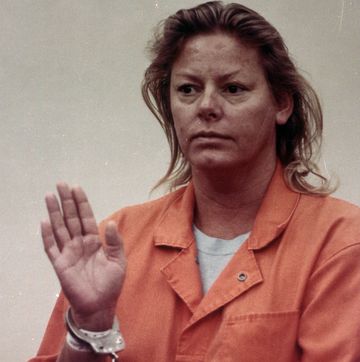Key takeaways:
- Aileen Wuornos wasn’t actually “America’s first female serial killer.”
- Wuornos’ crimes defied typical female killer patterns, sparking public fascination and a trial that cemented her femme fatale image.
- Netflix’s new documentary, Aileen: Queen of the Serial Killers, explores her life and crimes.
Although only a fraction of documented serial killers are women—around 12 to 15 percent, according to George Mason University—infamous figures such as Belle Gunness; the “Giggling Granny,” Nanny Doss; and Jane Toppan have left deadly legacies rivaling their male counterparts for more than a century.
So why was Aileen Wuornos falsely labeled “America’s first female serial killer” following her 1991 arrest?
A new Netflix documentary explores how Wuornos’ widely-publicized trial helped cement her image as a new breed of femme fatale. Aileen: Queen of the Serial Killers premieres Thursday, October 30, on Netflix and features prison interviews and other archival material of Wuornos.
While the shocking details of Wuornos’ crimes—she was convicted of six murders, confessed to a seventh, and eventually executed by lethal injection in 2002—and their Hollywood depiction in the Charlize Theron-led biographical movie Monster (2003) helped preserve her notoriety, there were other factors at play.
Wuornos’ crimes were atypical to previous female killers
Wuornos’ killings shared stark differences from those of other female killers, partly contributing to the public’s fascination with her case.
According to criminologist and professor Scott Bonn, female serial killers are typically motivated by comfort or gain—meaning they commit their crimes to some material end. This helped prompt the cultural image of the “Black Widow” killer, or a woman who murders three or more romantic partners for financial or property benefit.
While not necessarily romantic partners, the targets of female killers are often individuals from familiar spaces such as the home or workplace. “Although they comprise less than 15 percent of all serial killers, females are very effective in their work and they typically use quieter and less messy methods to kill than their male counterparts,” Bonn wrote for Psychology Today. “The methods they use for murder are more covert or low-profile, such as murder by poisoning.”
Toppan, a nurse who poisoned patients through morphine and other drugs, is a prime example.
While Wuornos, who met her victims through sex work, did partially kill for gain—robbing her victims afterward—she targeted strangers and used a gun, showing a drive for personal gratification more typical of male killers.
Wuornos claimed she killed in self-defense, but later retracted
Following her arrest in January 1991, Wuornos confessed to killing her victims in a phone conversation with her girlfriend, Tyria Moore, and later on police videotape.
During trial for the murder of her first victim, 51-year-old Richard Mallory, Wuornos argued she killed in self-defense and testified that Mallory had assaulted and raped her—contradicting her police confession. While Mallory did have a criminal history—previously serving prison time for attempted sexual assault—it was not entered into court as evidence.
“I have to say it. I killed them all because they got violent with me and I decided to defend myself,” Wuornos explained of her victims, according to Mary Hart’s book Fatal Women: Lesbian Sexuality and the Mark of Aggression. “I’m sure if after the fightin’ they found I had a weapon, they would’ve shot me. So I just shot them.”
Wuornos was convicted of first-degree murder in Mallory’s killing and sentenced to death, and she later pleaded no contest to the murders of David Spears, Troy Burress, and Charles “Dick” Humphreys and submitted guilty pleas for two others.
Eventually, Wuornos retracted her claims of self-defense. She was executed by lethal injection at age 46 on October 9, 2002, in Starke, Florida.
Wuornos’ story is the subject of notable Hollywood adaptations
No matter her actual motivations for murder, Wuornos remains at the forefront of true and fictional crime media through notable screen portrayals.
In addition to Theron’s starring role in Monster, which earned the actor an Academy Award, Lily Rabe played Wuornos in season 5 of TV’s American Horror Story. Another full-length movie, Aileen Wuornos: American Boogeywoman (2021), was inspired by Wuornos’ ill-fated marriage to Lewis Fell. Now, her real story is the subject of Netflix’s documentary, Aileen: Queen of the Serial Killers.
And with Netflix already confirming Lizzie Borden as the next subject of its Monster anthology series, it’s apparent that interest in female killers—alleged or otherwise—remains strong.
Watch Aileen: Queen of the Serial Killers starting Oct. 30
Aileen: Queen of the Serial Killers begins streaming Thursday, October 30, on Netflix and is produced by BBC Studios in collaboration with NBC News Studios.
According to Tudum, the Netflix documentary “explores the circumstances that shaped her life and crimes, and examines the broader questions surrounding her motivations and the judicial system’s response.”
Tyler Piccotti joined the Biography.com staff as an Associate News Editor and is now the News and Culture Editor. He previously worked as a reporter and copy editor for a daily newspaper recognized by the Associated Press Sports Editors. In his current role, he shares the true stories behind your favorite movies and TV shows and profiles rising musicians, actors, and athletes. When he's not working, you can find him at the nearest amusement park or movie theater and cheering on his favorite teams.

![Bob Kelley;Jake Erhart;Richard Mallory [Misc.];Larry Horzepa;Richard Vogel;Aileen Carol Wuornos [Misc.] Officials investigate Aileen Wuornos and the killing of Richard Mallory](https://hips.hearstapps.com/hmg-prod/images/e067b130-3727-4103-842b-9a505e653454.jpeg?crop=1xw:1xh;center,top&resize=980:*)












